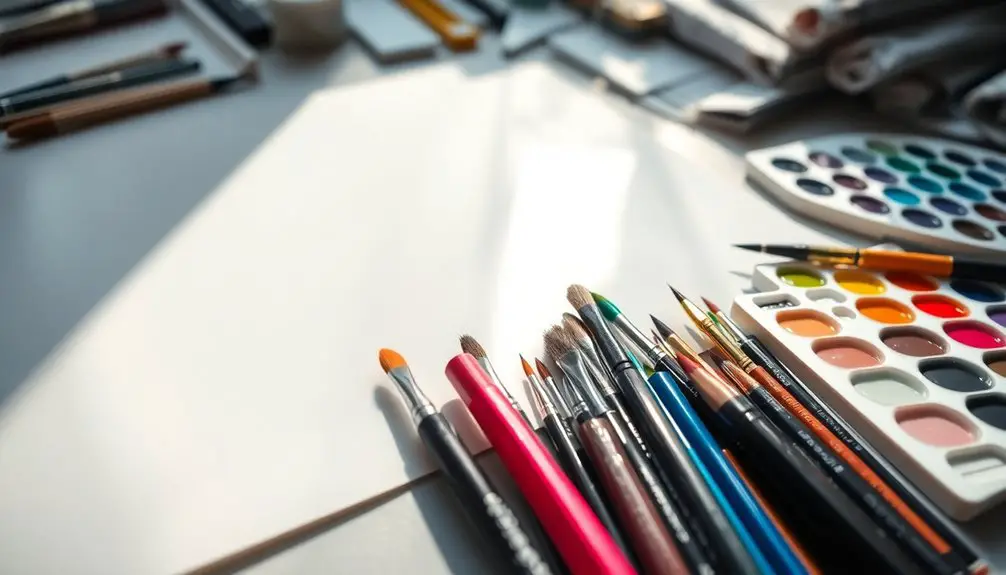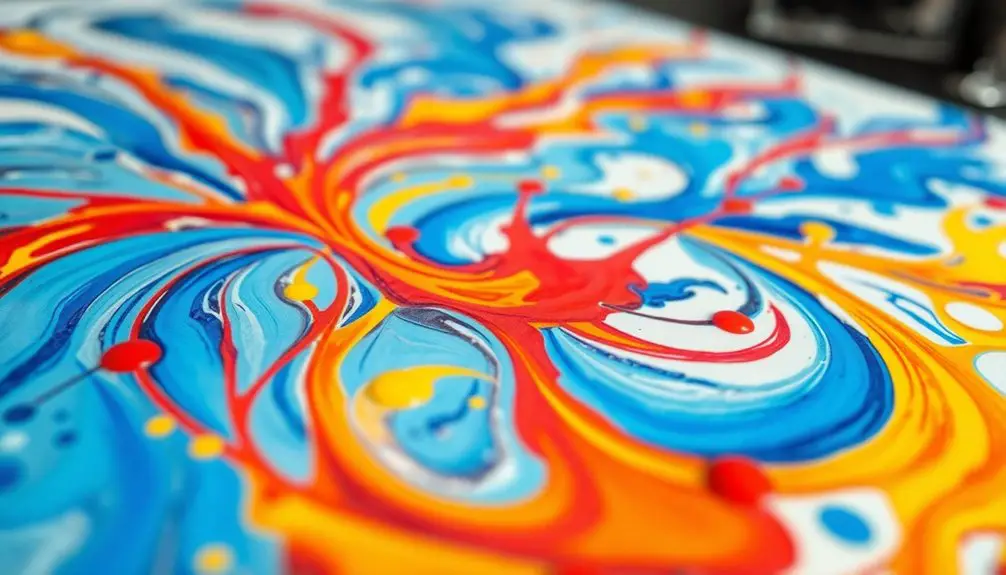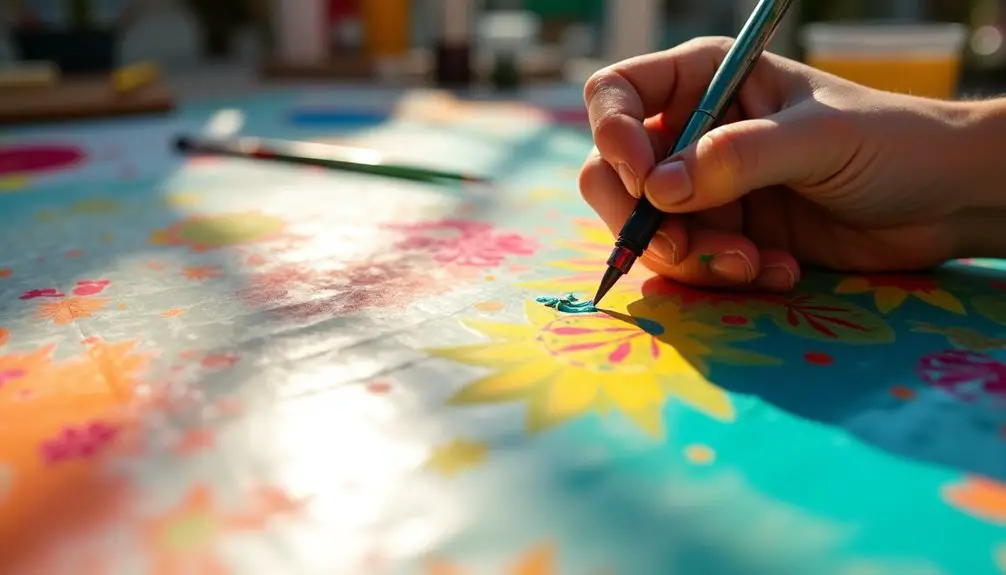To draw on polypropylene, you need to know a few key techniques. Start by preparing the surface with an acrylic primer, which helps paint adhere better. Use acrylic paints for excellent bonding, and apply thin layers for best results. Copic markers can also work well if you choose the right inks. Don't forget to conduct tests with different materials to find what works best for your project. Experiment with various tools, like smooth brushes or airbrushes, to achieve stunning effects. There's plenty more to explore that can elevate your polypropylene artwork even further.
Key Takeaways
- Use acrylic paints or Copic markers filled with permanent alcohol inks for optimal results on polypropylene surfaces.
- Apply an acrylic primer to enhance paint adhesion and prevent scratching.
- Conduct preliminary tests with various paint types to determine compatibility with polypropylene.
- Experiment with thin layers and allow adequate drying time to achieve desired effects.
- Consider using airbrush techniques for smooth gradients and detailed applications on prepared surfaces.
Understanding Polypropylene Properties
When working with polypropylene, it's essential to understand its unique properties. This synthetic material, such as Yupo, features a smooth surface that can cause paint to slide off if you're not careful. Before you dive into your project, you should test different paints for compatibility, as PVC alternatives like polypropylene require careful consideration due to their distinct characteristics. Since polypropylene is non-absorbent, it won't buckle or curl like traditional materials when exposed to water, giving you the freedom to explore unique artistic techniques.
To achieve better adhesion, consider using an acrylic primer. This can significantly improve grip on the surface, allowing your paint to adhere more effectively.
Keep in mind that polypropylene substrates exhibit one-directional drying, impacting your application techniques and drying times. This characteristic can influence how you layer your paints or apply various effects.
Finally, the weight of the polypropylene film, ranging from 155-390 GSM, also plays a role in its sturdiness and suitability for different projects.
Always pay attention to surface preparation to ensure your artwork stands the test of time. By understanding these properties, you'll set yourself up for success in your artistic endeavors.
Best Practices for Painting
Understanding polypropylene properties sets the stage for exploring best practices for painting on this unique material. To achieve excellent adhesion and a lasting finish, follow these essential tips:
- Use Acrylic Paint: Opt for acrylic paint, as it's been tested to outperform other types on polypropylene's slick surface. Its formulation provides excellent adhesion crucial for durability.
- Prepare the Surface: Always start by applying an acrylic primer. This step enhances paint grip and minimizes the risk of scratching during your application, ensuring a smoother outcome.
- Experiment with Absorbent Grounds: If you're using watercolors, try applying absorbent grounds to the polypropylene. This technique boosts paint adherence and prevents beading, allowing for more controlled applications.
- Apply Thin Layers: When painting, apply thin layers and allow adequate drying time. Remember, oil paints can take about two days to dry to the touch on polypropylene, so plan your work accordingly.
Before diving into your project, conduct preliminary tests with different paint types on a small section of the polypropylene film. This will help you determine the best compatibility for your artistic vision.
Recommended Tools and Materials

Choosing the right tools and materials is crucial for successful artwork on polypropylene. For vibrant colors and easy blending, you should use Copic markers, which are filled with permanent alcohol inks designed to adhere well to plastic materials.
If you prefer painting, consider acrylic paints. They offer superior adhesion properties on polypropylene, especially when you use bonding primers to enhance durability.
When applying acrylics, employ a smooth brush or an airbrush for a seamless finish. The slick surface of polypropylene can cause other application methods to slip, so it's essential to choose your tools wisely.
Additionally, you might want to use preparatory tools like sandpaper to roughen the surface. This helps improve paint adhesion and reduces the chances of scratching.
Don't shy away from experimenting with different acrylic mediums, such as GAC 200. This can help increase the flexibility and durability of your artwork on polypropylene substrates.
Acrylic paints, which are known for their low VOC options, provide a healthier alternative for artists working in small, enclosed spaces.
Techniques for Enhanced Adhesion
A variety of techniques can significantly enhance adhesion on polypropylene surfaces, ensuring your artwork stays vibrant and intact.
By employing these methods, you'll achieve better results and enjoy a more seamless creative process.
1. Use an acrylic primer****: This helps paint grip better on the smooth texture of polypropylene, creating a solid base for your artwork.
2. Apply an absorbent ground****: If you're using water-based mediums, this can drastically improve paint adherence, preventing sliding and offering better control during application.
3. Conduct preliminary tests****: Try out various types of paint on polypropylene to determine which ones work best.
This step is crucial for assessing compatibility and adhesion efficacy before tackling larger projects.
4. Opt for bonding primers****: These are specifically designed for non-porous surfaces and can help establish a strong bond between the paint and the polypropylene film.
Using a combination of these techniques and applying a coat of PET plastic primer can help ensure a strong bond and lasting results.
Creative Project Ideas

Polypropylene offers a versatile canvas for artists looking to unleash their creativity. One exciting project idea is to use Copic markers on freshly waxed polypropylene film. Their alcohol-based inks adhere beautifully, allowing for vibrant, streak-free applications when you work swiftly.
If you prefer acrylics, consider layering them on the surface. Just remember to apply a bonding primer first to enhance adhesion and durability.
For a unique twist, experiment with diluted washes of acrylic paint, creating textures that stand out. Be mindful of working quickly to avoid puddling, especially since dried acrylic can be slower drying on polypropylene.
If you're interested in mixed media, try coloring the backside of clear polypropylene sheets. This technique lets the light enhance your colors, giving your work a stunning effect.
Lastly, explore airbrushing techniques to achieve smooth gradients. Before you start, clean the surface well to prevent beading and ensure optimal ink flow.
With these creative project ideas, you'll transform polypropylene into captivating works of art that showcase your unique style!
Frequently Asked Questions
Can You Draw on Polypropylene?
Yes, you can draw on polypropylene! Just make sure the surface is clean and experiment with different mediums. You'll find some work better than others, so testing is key for the best results.
What Paint Will Stick to Polypropylene?
To ensure paint sticks to polypropylene, use acrylic paint for the best adhesion. Prepping the surface with an acrylic primer improves grip. Test different types to find what works best for your project.
How to Paint on Polypropylene?
To paint on polypropylene, start by priming the surface with an acrylic primer. Then, use acrylic paint for best adhesion. Experiment with different paints to see which works best for your project before diving in.
What Can You Use to Draw on Plastic?
You can use permanent markers, acrylic paint, or paint markers designed for plastics to draw on plastic. Copic markers and gel pens also work well, but always test them first to ensure compatibility.

